
Transient absorption of warm dense matter created by an X-ray free-electron laser
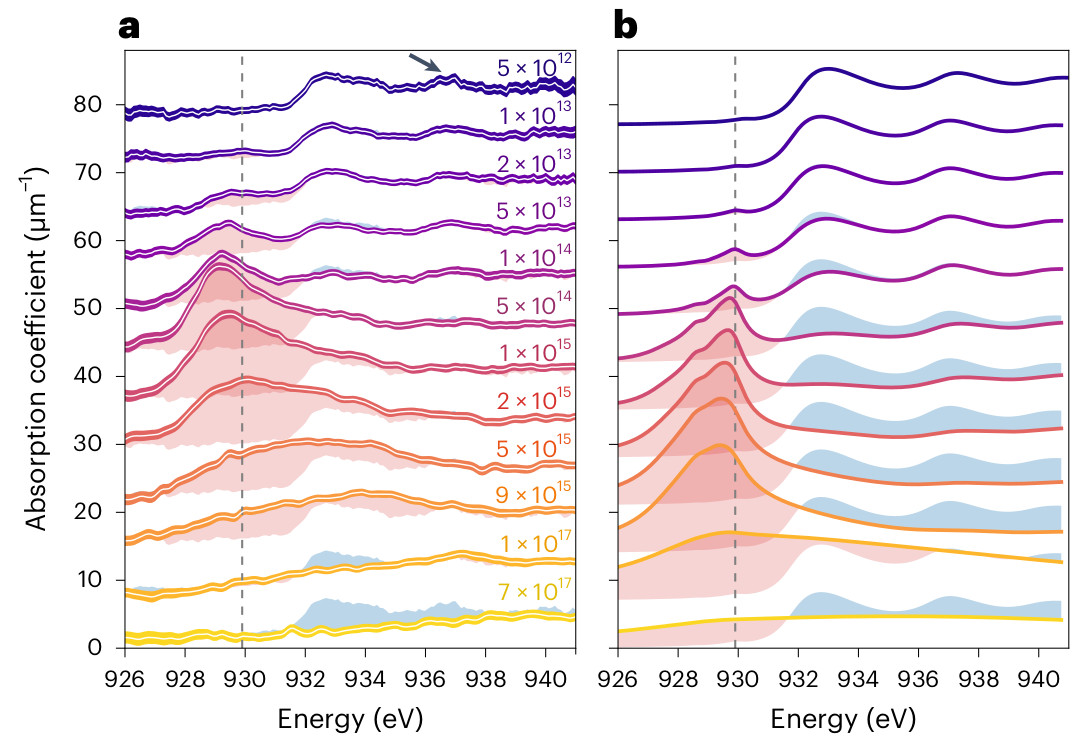
Warm dense matter is at the boundary between a plasma and a condensed
phase and plays a role in astrophysics, planetary science and inertial
confinement fusion research. However, its electronic structure and
ionic structure upon irradiation with strong laser pulses remain poorly
understood. Here, we use an intense and ultrafast X-ray free-electron laser
pulse to simultaneously create and characterize warm dense copper using
L-edge X-ray absorption spectroscopy over a large irradiation intensity
range. Below a pulse intensity of 1015 W cm-2, an absorption peak below
the L edge appears, originating from transient depletion of the 3d band.
This peak shifts to lower energy with increasing intensity, indicating the
movement of the 3d band upon strong X-ray excitation. At higher intensities,
substantial ionization and collisions lead to the transition from reverse
saturable absorption to saturable absorption of the X-ray free-electron
laser pulse, two nonlinear effects that hold promise for X-ray pulse-shaping.
We employ theoretical calculations that combine a model based on kinetic
Boltzmann equations with finite-temperature real-space density-functional
theory to interpret these observations. The results can be used to benchmark
non-equilibrium models of electronic structure in warm dense matter.
Nature Physics 2024, EurekAlert!

Insulating Half-Heusler TmPdSb with Unusual Band Order and Metallic Surface States
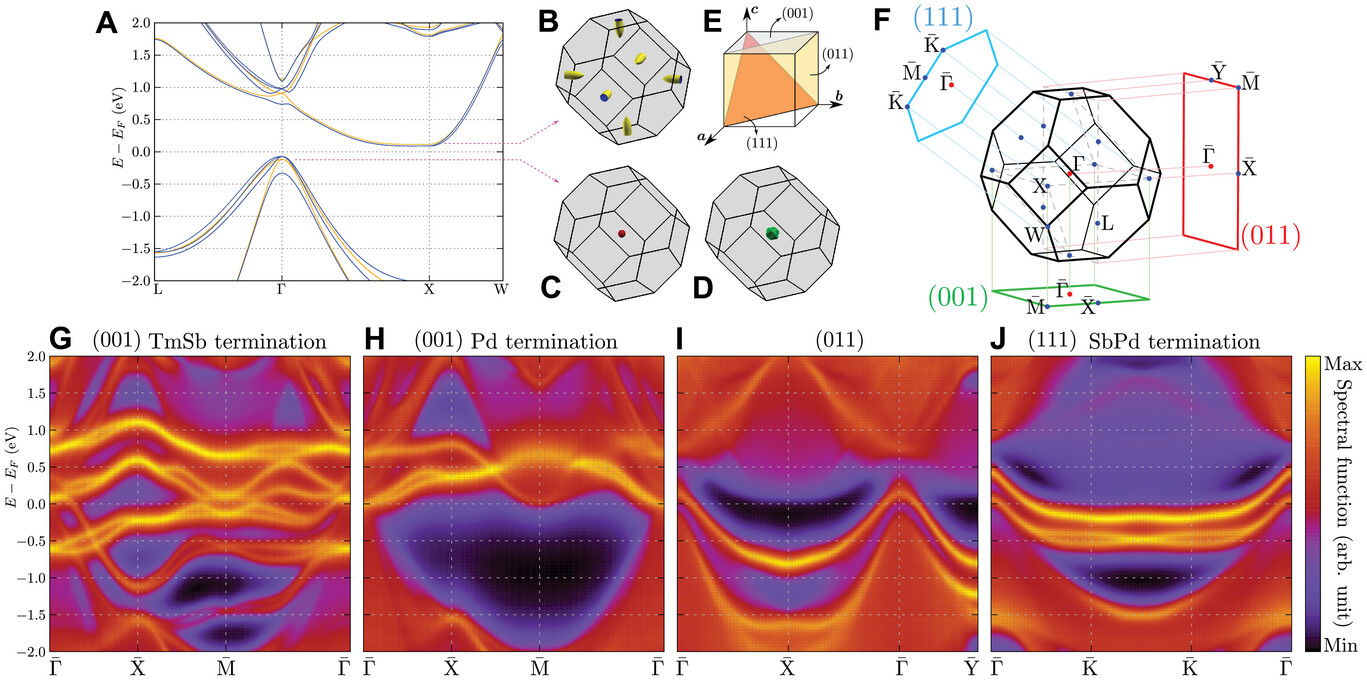
Theoretical and experimental results exploring a half-Heusler compound TmPdSb with unusual band order and metallic surface states are presented. Typically, the half-Heusler systems exhibit topological features in a semimetallic state, and trivial ones in an insulating state. Topological properties of the most of half-Heusler systems are related to the band inversion around the Fermi level, similar to this observed in CdTe/HgTe systems. In the case of TmPdSb, the gapped electronic band structure with “band inversion” in the conductance band is observed, while the slab-like system realized metallic surface states. The bulk insulating nature of the compound is corroborated by means of electrical transport measurements. The experimental data reveal several features due to the presence of metallic surface states, such as linear magnetoresistance and weak-antilocalization effect, characterized by enhanced coherence length and a very large number of surface conductive channels. The findings reveal new features of the rare-earth bearing half-Heusler.
Adv. Funct. Mater. 2024, 2402415

Femtosecond Reduction of Atomic Scattering Factors Triggered by Intense X-Ray Pulse
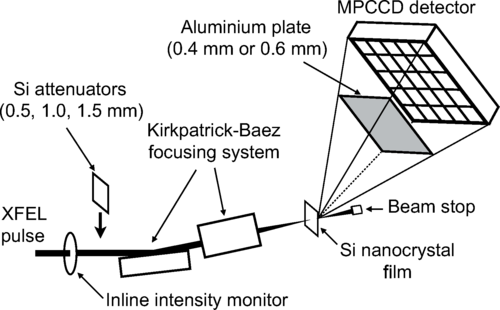
X-ray diffraction of silicon irradiated with tightly focused femtosecond x-ray pulses (photon energy, 11.5 keV; pulse duration, 6 fs) was measured at various x-ray intensities up to 4.6×10^19 W/cm2. The measurement reveals that the diffraction intensity is highly suppressed when the x-ray intensity reaches of the order of 10^19 W/cm2. With a dedicated simulation, we confirm that the observed reduction of the diffraction intensity can be attributed to the femtosecond change in individual atomic scattering factors due to the ultrafast creation of highly ionized atoms through photoionization, Auger decay, and subsequent collisional ionization. We anticipate that this ultrafast reduction of atomic scattering factor will be a basis for new x-ray nonlinear techniques, such as pulse shortening and contrast variation x-ray scattering.
Phys. Rev. Lett. 131 (2023) 163201

Influence of anharmonicity on the negative thermal expansion of alpha−Sn

The lattice vibrational properties of α−Sn (gray tin) were investigated experimentally by temperature-dependent x-ray diffraction and theoretically by density functional theory calculations. Similar to the other elements of group IV, α−Sn exhibits a lattice anomaly at low temperatures and negative thermal expansion, with a minimum at ∼27K and a magnitude three times larger than in Si. The influence of anharmonic effects up to fourth-order potential terms on the phonon dispersion relations, the lattice parameters, and the thermal expansion coefficient have been tested. The performed analysis gives an excellent agreement with experiment when quartic potential terms are included in the theory. We point out that negative thermal expansion in α−Sn is not driven by the anharmonicity of the interatomic potential. This resolves the long-standing puzzle in the thermal behavior of α−Sn.
Phys. Rev. Materials 6 (2022) 113601

Modeling of ultrafast X-ray induced magnetization dynamics in magnetic multilayer systems

In this work, we report on modeling results obtained with our recently developed simulation tool enabling nanoscopic description
of electronic processes in X-ray irradiated ferromagnetic materials. With this tool, we have studied the response of Co/Pt multilayer system irradiated by an ultrafast extreme ultraviolet pulse at the M-edge of Co (photon energy ~60 eV). It was previously
investigated experimentally at the FERMI free-electron-laser facility, using the magnetic small-angle X-ray scattering technique. Our simulations show that the magnetic scattering signal from cobalt decreases on femtosecond timescales due to electronic excitation, relaxation, and transport processes both in the cobalt and in the platinum layers, following the trend observed in the experimental data. The confirmation of the predominant role of electronic processes for X-ray induced demagnetization in the regime below the structural damage threshold is a step toward quantitative control and manipulation of X-ray induced magnetic processes on
femtosecond timescales.
npj Computational Materials (2022) 8:212

Delayed Onset and Directionality of X-Ray-Induced Atomic Displacements Observed on Subatomic Length Scales
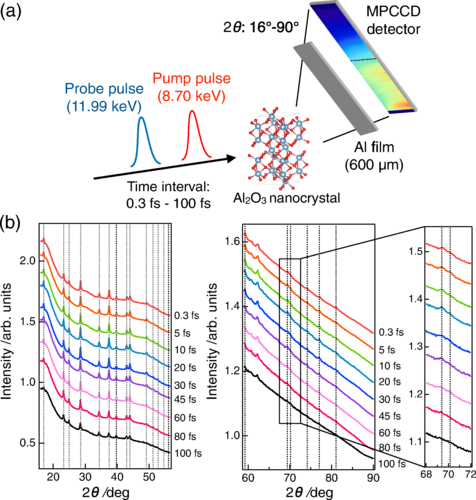
Transient structural changes of Al2O3 on subatomic length scales following irradiation with an intense x-ray laser pulse have been investigated by using an x-ray pump x-ray probe technique. The measurement reveals that aluminum and oxygen atoms remain in their original positions by ∼20 fs after the intensity maximum of the pump pulse, followed by directional atomic displacements at the fixed unit cell parameters. By comparing the experimental results and theoretical simulations, we interpret that electron excitation and relaxation triggered by the pump pulse modify the potential energy surface and drives the directional atomic displacements. Our results indicate that high-resolution x-ray structural analysis with the accuracy of 0.01 Å is feasible even with intense x-ray pulses by making the pulse duration shorter than the timescale needed to complete electron excitation and relaxation processes, which usually take up to a few tens of femtoseconds.
Phys. Rev. Lett. 128 (2022) 223203

Ultrafast melting of diamond

An international team of scientists has found evidence of an unconventional 'non-thermal' melting process in diamond induced by an intense X-ray free-electron laser beam. While in conventional melting the heated atoms of a sample start moving stronger and stronger until the interatomic bonds break, the intense X-ray laser flashes can excite so many electrons that this reorganizes the interatomic potential on femtosecond timescale (10^-15 s) and breaks the bonds between carbon atoms apart straight away. The scientists around Ichiro Inoue from the RIKEN SPring-8 Center in Japan, Eiji Nishibori from University of Tsukuba in Japan and DESY & INP PAS scientist Beata Ziaja have recently reported their observations on X-ray induced ultrafast melting of diamond in the journal Physical Review Letters.
Phys. Rev. Lett 126 (2021) 117403

Discovery of the soft electronic modes of the trimeron order in magnetite

Magnetite (Fe3O4) was the first magnetic material discovered already in ancient Greece.
Verwey observed the dramatic drop of the electric conductivity by two orders of magnitude at temperature T = 125 K and proposed the charge ordering on iron ions as the mechanism of the phase transition.
It was demonstrated in recent years that the fundamental building blocks of the charge-ordered structure are three-site small polarons called trimerons (see the inset of the figure). However, electronic collective modes of this trimeron order have not been detected to date, and thus an understanding of the dynamics of the Verwey transition from an electronic point of view was still lacking. In the present studies, the signatures of the low-energy electronic excitations of the charge-orbital order were observed using the terahertz optical spectroscopy at the Massachusetts Institute of Technology. By driving these modes coherently with an ultrashort laser pulse towards the Verwey transition, the critical softening was observed. These findings shed new light on the cooperative mechanism at the origin of magnetite’s exotic ground state. We proposed that these excitations can be described by oscillations of the charge-orbital-lattice order using a model of coherent polaron tunneling. In the calculations performed in Cracow, we used the density functional theory to obtain the potential energy barrier for the tunneling process involving localized charge carriers on the central Fe sites of the trimerons. The characteristic energies of atomic vibrations coupled to tunneling electrons were calculated with the software PHONON (phonon density of states in magnetite is presented in the figure). The critical behavior of the experimentally observed collective modes was successfully reproduced within the time-dependent Ginsburg-Landau theory.

Phonon confinement and spin-phonon coupling in tensile-strained ultrathin EuO films
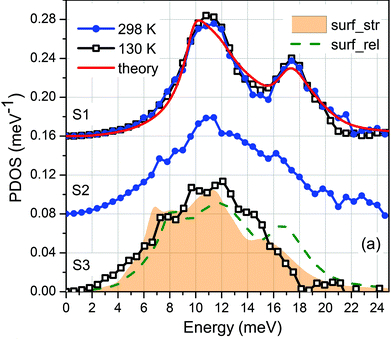
Reducing the material sizes to the nanometer length scale leads to drastic modifications of the propagating lattice excitations (phonons) and their interactions with electrons and magnons. In EuO, a promising material for spintronic applications in which a giant spin-phonon interaction is present, this might imply a reduction of the degree of spin polarization in thin films. Therefore, a comprehensive investigation of the lattice dynamics and spin-phonon interaction in EuO films is necessary for practical applications. We report a systematic lattice dynamics study of ultrathin EuO(001) films using nuclear inelastic scattering on the Mössbauer-active isotope 151Eu and first-principles theory. The films were epitaxially grown on YAlO3(110), which induces a tensile strain of ca. 2%. By reducing the EuO layer thickness from 8 nm to a sub-monolayer coverage, the Eu-partial phonon density of states (PDOS) reveals a gradual enhancement of the number of low-energy phonon states and simultaneous broadening and suppression of the peaks. These deviations from bulk features lead to significant anomalies in the vibrational thermodynamic and elastic properties calculated from the PDOS. The experimental results, supported by first-principles theory, unveil a reduction of the strength of the spin-phonon interaction in the tensile-strained EuO by a factor of four compared to a strain-free lattice.

Precise extrapolation of the correlation function in tensor networks
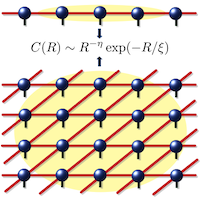
A complex quantum physical system may display emergent behavior that is very different from those of its individual parts. Precise descriptions of those phenomena, such as high-temperature superconductivity, are very challenging and usually require sophisticated numerical methods. Tensor networks, a powerful tool for simulating strongly correlated systems, have recently emerged as one such method. While they excel at predicting local observables, they are much worse at computing nonlocal properties that are a key ingredient for continuous phase transitions. Here, we show how to precisely extract that information from the commonly used uniform tensor network representation. This information is encoded in the correlation function and, more precisely, in the rate of its decay at very long distances. We analyze how the information is distorted by an approximation imposed by tensor network description. Understanding this allows us to provide a procedure to precisely extrapolate nonlocal properties of the quantum state. We also provide new insight into how the information about nonlocal characteristics of the exact quantum state is encoded in the uniform tensor network. This promises to extend the range of problems where uniform tensor networks can be accurately applied. Our method provides the means for detailed studies of phase diagrams of quantum models both in one and two dimensions.

Lattice dynamics of epitaxial strain-free interfaces
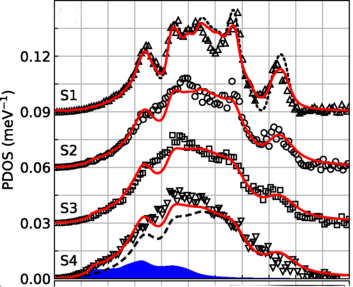
We have performed a systematic lattice dynamics study of the technologically important Fe3Si/GaAs heterostructure for Fe3Si layer thicknesses of 3, 6, 8, and 36 monolayers. The Fe-partial phonon density of states obtained by nuclear inelastic scattering at the ID18 beamline in ESRF exhibits up to a twofold enhancement of the low-energy phonon states compared to the bulk material for layer thicknesses of 8 monolayers and below. First-principles calculations explain the observed effect by interface-specific phonon states originating from the significantly reduced atomic force constants and allow for achieving a comprehensive understanding of the lattice dynamics of epitaxial strain-free interfaces.
Phys. Rev. B 98, 121409(R) (2018)

Finite Correlation Length Scaling with Infinite Projected Entangled-Pair States

We show how to accurately study two-dimensional quantum critical phenomena using infinite projected entangled-pair states (iPEPS). We identify the presence of a finite correlation length in the optimal iPEPS approximation to Lorentz-invariant critical states which we use to perform a finite correlation length scaling analysis to determine critical exponents. This is analogous to the one-dimensional finite entanglement scaling with infinite matrix product states. We provide arguments why this approach is also valid in 2D by identifying a class of states that, despite obeying the area law of entanglement, seems hard to describe with iPEPS. We apply these ideas to interacting spinless fermions on a honeycomb lattice and obtain critical exponents which are in agreement with quantum Monte Carlo results. Furthermore, we introduce a new scheme to locate the critical point without the need of computing higher-order moments of the order parameter. Finally, we also show how to obtain an improved estimate of the order parameter in gapless systems, with the 2D Heisenberg model as an example.
Phys. Rev. X 8, 031031 (2018), arXiv:1803.08445

Reentrant Fulde-Ferrell-Larkin-Ovchinnikov superfluidity in the honeycomb lattice

We study superconducting properties of population-imbalanced ultracold Fermi mixtures in the honeycomb lattice that can be effectively described by the spin-imbalanced attractive Hubbard model in the presence of a Zeeman magnetic field. We use the mean-field theory approach to obtain ground-state phase diagrams including the unconventional Fulde-Ferrell-Larkin-Ovchinnikov (FFLO) phase, which is characterized by atypical behavior of the Cooper-pair total momentum. We show that the momentum changes its value as well as direction with a change of the system parameters. Moreover, we discuss the influence of Van Hove singularities on the possibility of the reentrant FFLO phase occurrence, without a BCS precursor.
Phys. Rev. A 97, 053619 (2018), arXiv:1710.06395

Superconducting monolayer deposited on substrate: Effects of the spin-orbit coupling induced by proximity effects

The spin-orbit coupling can lead to exotic states of matter and unexpected behavior of the system properties. In this paper, we investigate the influence of spin-orbit coupling induced by proximity effects on a monolayer of superconductor (with s-wave or d-wave pairing) placed on an insulating bulk. We show that the critical temperatures Tc of the superconducting states can be tuned by the spin-orbit coupling both in the case of on-site and inter-site pairing. Moreover, we discuss a possibility of changing the location of the maximal Tc from the half-filling into the underdoped or overdoped regimes.
Phys. Rev. Materials 2, 024801 (2018), arXiv:1801.08055

